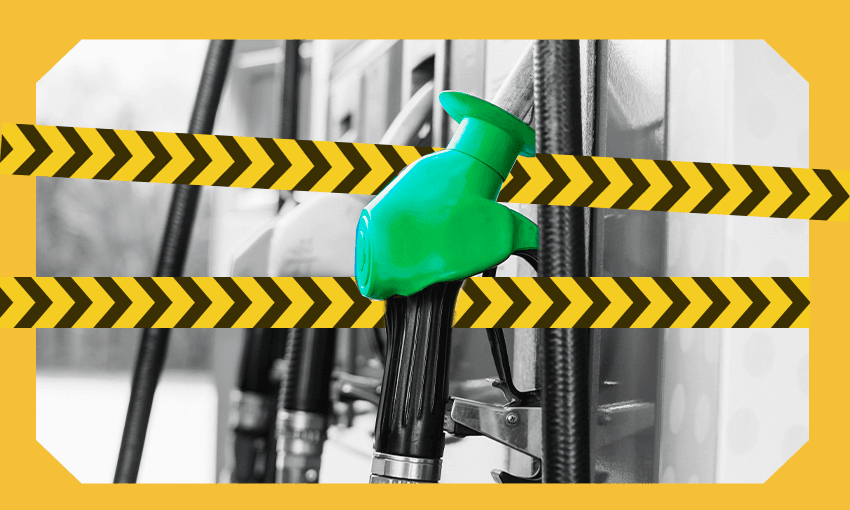When natural disasters hit, petrol stations become hubs of activity as people try to flee, conduct rescue missions or stock up in case of further destruction. But the logistics of keeping the fuel pumping when key infrastructure is down requires many hands.
As Cyclone Gabrielle struck Tairāwhiti, Z Energy’s (Z) communications in the area went out. At Wairoa, the fibre connection between the pumps, the point-of-sale and the main server which allocates fuel was down, meaning digital transactions became impossible. Down the coast, retailer Hamish Waddington lost contact with his staff.
“Wairoa is prone to a lot of power outages, they’re normally short, so we’ve had them frequently but we never considered we’d have one for that long,” he says. “Without communications up and running, we can’t dispense fuel in the normal manner. Our manager – whose house was flooded – had to operate on a manual system where we pumped fuel for people and kept paper records of how many litres were dispensed to which people at what time.”
The first contact came via a Starlink satellite connection, a call from the council asking for help. Contractors and emergency services needed access to fuel to clear roads and conduct patrols for people in danger. Regular customers weren’t going far, but the boats, trucks and tractors on the roads soon chunked into the local supply. And without power, generators and gas bottles were quickly in high demand.
“The local marae was using gas bottles at a great rate,” says Waddington. “The marae are amazing, they are cooking and providing somewhere to sleep for a lot of people. They were really like a Civil Defence hub. It blew me away how a lot of those old communal methods of looking after each other really kicked in.”
There could have been panic. In other natural disasters, says Waddington, there has been a run on the pumps as people tried to flee the affected area. But with the roads closed, there wasn’t time to get out. The damage to infrastructure was too severe.
“It was the scale of the closures,” says Logan Beaumont, Z integrated supply chain manager. “There were just a huge number of them.”
Beaumont’s job is to prepare for the unexpected, so weather conditions are a key consideration. But Gabrielle exceeded all expectations. The severity of the storm impacted every link in the chain, creating a self-perpetuating spiral of challenges.
“You need power on at the terminal to be able to get fuel off a ship, or to load fuel on to trucks. You then need roading networks available to be able to deliver the fuel. To understand which roads are available you need communications. You also need communications to know which sites are operational, and how much fuel is available at those sites. To get the communication towers up and running, you either need power, or you need fuel for the generators.”
As a key lifeline utility, Z operates under the National Fuel Plan which sets out the emergency response and readiness framework for the government and fuel supply industry. When an emergency response is triggered, the sector comes together as the Fuel Sector Coordinating Entity (FSCE), led by the Ministry of Business, Innovation and Employment (MBIE). The purpose of this is to coordinate sharing of information between fuel companies, the National Emergency Management Agency (NEMA) and local Civil Defence Emergency Management authorities.
The FSCE allows fuel companies to work collectively to resolve any issues with fuel stations that may be affected due to road access or power outages, ensuring supplies continue to be delivered and emergency services prioritised.
Luckily for those needing fuel in the immediate wake of this disaster, many Z stations are wired for generators to get fuel pumps and payment infrastructure back up and running before power is restored. As Gabrielle’s destruction was ongoing, Z worked to find alternative routes to deliver fuel to regions that were cut off at certain access points, and adjust delivery schedules and plans to truck fuel in from Wellington and Mt Maunganui terminals when the power was out at their Napier terminal. All of these quick moves were made possible by years of planning. But the work doesn’t stop there.
Sustained road closures from Cyclone Gabrielle have created ongoing issues. Waddington explains how fuel that would normally be trucked north from the port at Napier has been rerouted to Tauranga, turning an eight hour return trip into a two-day affair. Power outages and communication issues have also highlighted the dangers of a multifaceted natural disaster where the effects reverberate across sectors. As Beaumont points out, “None of [the disruption was] necessarily surprising, but it was the combination of all of those aspects in tandem that was unprecedented.”
“You can’t have a system that is resilient to every conceivable event, so you want one that is capable during the most common occurrences. The fuel system and the people who stood up to manage the situation handled it really well, but there are learnings around how much worse these weather events can be and how we further enhance our response.”
Ensuring New Zealand’s fuel supply stays safe and reliable is a job that takes collaboration and care from the whole industry. Maintaining reliability through the ongoing impacts of Cyclone Gabrielle, and for future extreme weather events, is what suppliers like Z are working to do – so that New Zealanders know they can keep moving after a disaster.

